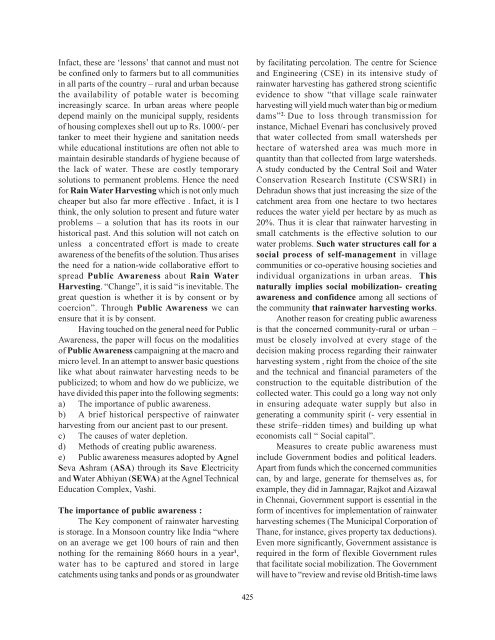Accepted Papers - 3.pdf - UNESCO
Accepted Papers - 3.pdf - UNESCO
Accepted Papers - 3.pdf - UNESCO
You also want an ePaper? Increase the reach of your titles
YUMPU automatically turns print PDFs into web optimized ePapers that Google loves.
Infact, these are ‘lessons’ that cannot and must not<br />
be confined only to farmers but to all communities<br />
in all parts of the country – rural and urban because<br />
the availability of potable water is becoming<br />
increasingly scarce. In urban areas where people<br />
depend mainly on the municipal supply, residents<br />
of housing complexes shell out up to Rs. 1000/- per<br />
tanker to meet their hygiene and sanitation needs<br />
while educational institutions are often not able to<br />
maintain desirable standards of hygiene because of<br />
the lack of water. These are costly temporary<br />
solutions to permanent problems. Hence the need<br />
for Rain Water Harvesting which is not only much<br />
cheaper but also far more effective . Infact, it is I<br />
think, the only solution to present and future water<br />
problems – a solution that has its roots in our<br />
historical past. And this solution will not catch on<br />
unless a concentrated effort is made to create<br />
awareness of the benefits of the solution. Thus arises<br />
the need for a nation-wide collaborative effort to<br />
spread Public Awareness about Rain Water<br />
Harvesting. “Change”, it is said “is inevitable. The<br />
great question is whether it is by consent or by<br />
coercion”. Through Public Awareness we can<br />
ensure that it is by consent.<br />
Having touched on the general need for Public<br />
Awareness, the paper will focus on the modalities<br />
of Public Awareness campaigning at the macro and<br />
micro level. In an attempt to answer basic questions<br />
like what about rainwater harvesting needs to be<br />
publicized; to whom and how do we publicize, we<br />
have divided this paper into the following segments:<br />
a) The importance of public awareness.<br />
b) A brief historical perspective of rainwater<br />
harvesting from our ancient past to our present.<br />
c) The causes of water depletion.<br />
d) Methods of creating public awareness.<br />
e) Public awareness measures adopted by Agnel<br />
Seva Ashram (ASA) through its Save Electricity<br />
and Water Abhiyan (SEWA) at the Agnel Technical<br />
Education Complex, Vashi.<br />
The importance of public awareness :<br />
The Key component of rainwater harvesting<br />
is storage. In a Monsoon country like India “where<br />
on an average we get 100 hours of rain and then<br />
nothing for the remaining 8660 hours in a year 1 ,<br />
water has to be captured and stored in large<br />
catchments using tanks and ponds or as groundwater<br />
425<br />
by facilitating percolation. The centre for Science<br />
and Engineering (CSE) in its intensive study of<br />
rainwater harvesting has gathered strong scientific<br />
evidence to show “that village scale rainwater<br />
harvesting will yield much water than big or medium<br />
dams” 2. Due to loss through transmission for<br />
instance, Michael Evenari has conclusively proved<br />
that water collected from small watersheds per<br />
hectare of watershed area was much more in<br />
quantity than that collected from large watersheds.<br />
A study conducted by the Central Soil and Water<br />
Conservation Research Institute (CSWSRI) in<br />
Dehradun shows that just increasing the size of the<br />
catchment area from one hectare to two hectares<br />
reduces the water yield per hectare by as much as<br />
20%. Thus it is clear that rainwater harvesting in<br />
small catchments is the effective solution to our<br />
water problems. Such water structures call for a<br />
social process of self-management in village<br />
communities or co-operative housing societies and<br />
individual organizations in urban areas. This<br />
naturally implies social mobilization- creating<br />
awareness and confidence among all sections of<br />
the community that rainwater harvesting works.<br />
Another reason for creating public awareness<br />
is that the concerned community-rural or urban –<br />
must be closely involved at every stage of the<br />
decision making process regarding their rainwater<br />
harvesting system , right from the choice of the site<br />
and the technical and financial parameters of the<br />
construction to the equitable distribution of the<br />
collected water. This could go a long way not only<br />
in ensuring adequate water supply but also in<br />
generating a community spirit (- very essential in<br />
these strife–ridden times) and building up what<br />
economists call “ Social capital”.<br />
Measures to create public awareness must<br />
include Government bodies and political leaders.<br />
Apart from funds which the concerned communities<br />
can, by and large, generate for themselves as, for<br />
example, they did in Jamnagar, Rajkot and Aizawal<br />
in Chennai, Government support is essential in the<br />
form of incentives for implementation of rainwater<br />
harvesting schemes (The Municipal Corporation of<br />
Thane, for instance, gives property tax deductions).<br />
Even more significantly, Government assistance is<br />
required in the form of flexible Government rules<br />
that facilitate social mobilization. The Government<br />
will have to “review and revise old British-time laws

















